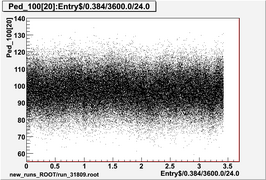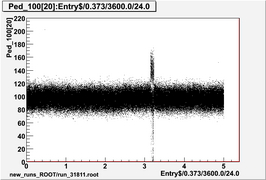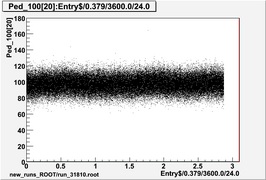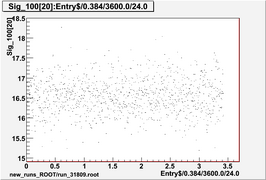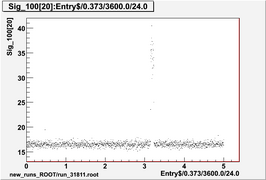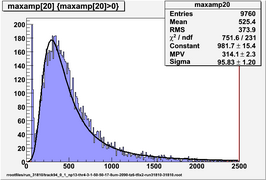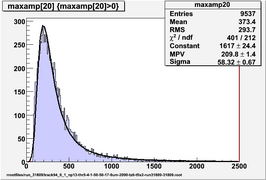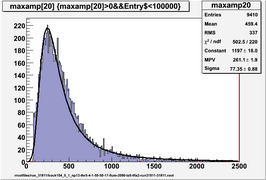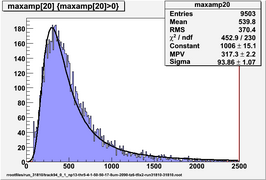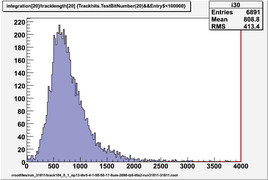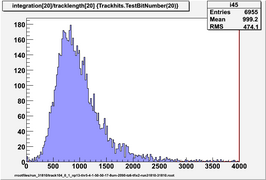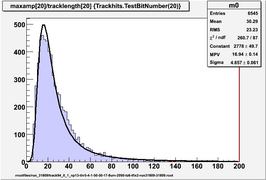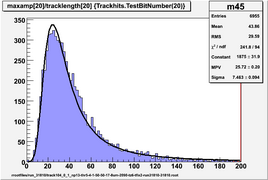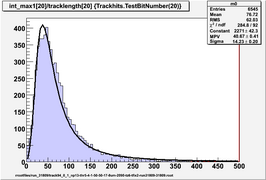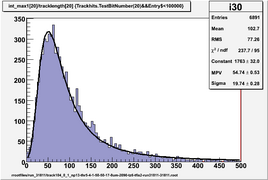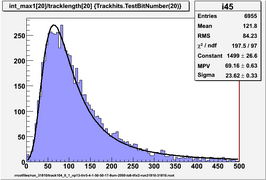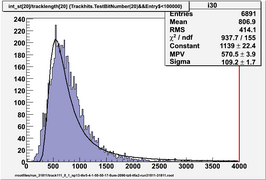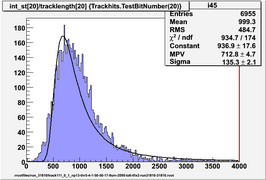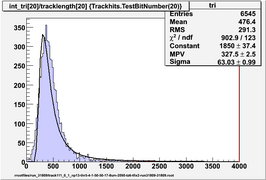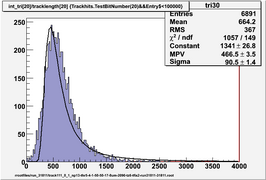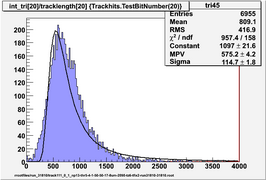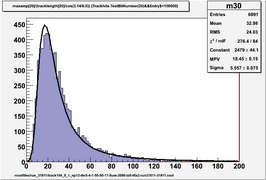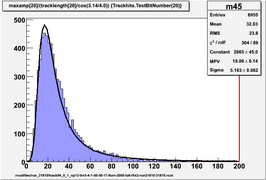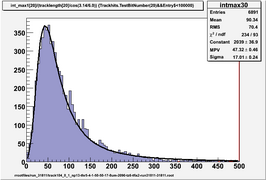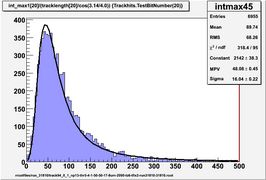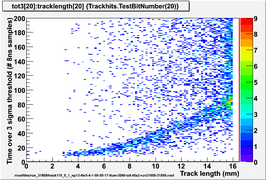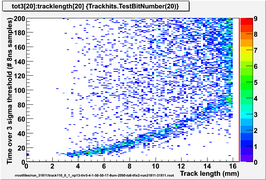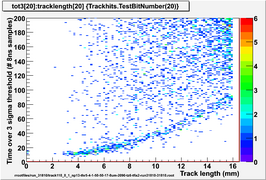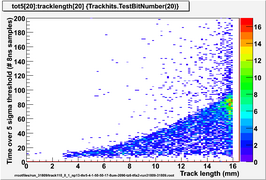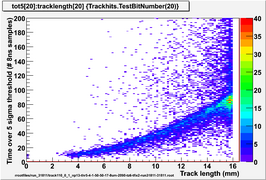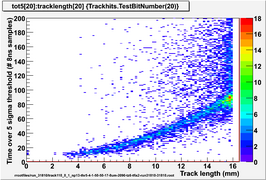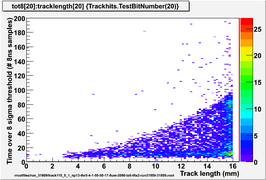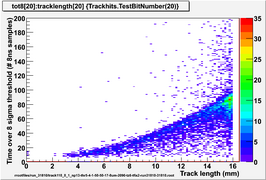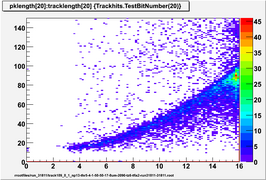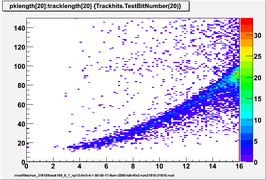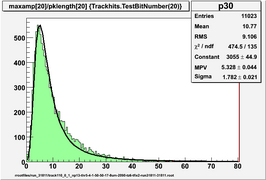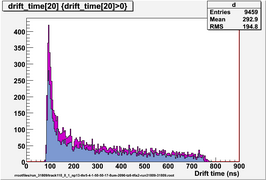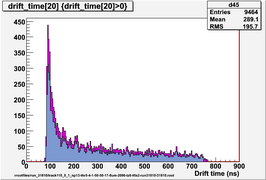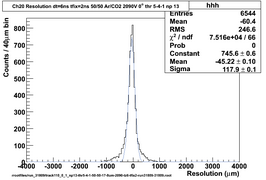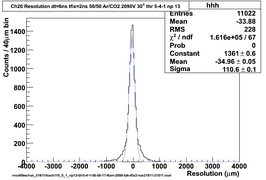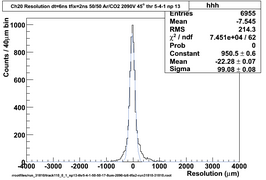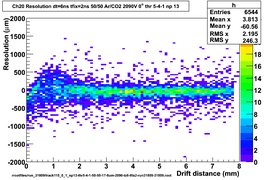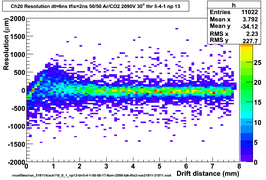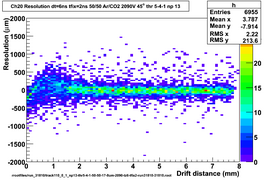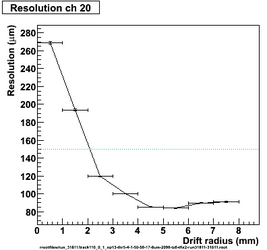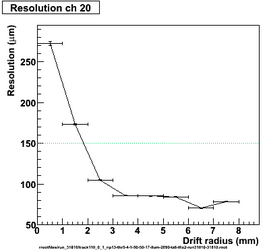CDC signal integration new
Cosmics, 50/50 gas, 2090V
Comparison with old (underpowered preamp) data is at CDC_signal_integration
Run numbers are 31809 (horiz) 31810 (45 deg) and 31811 (30 deg) at 3.0V, 2.09kV
Contents
- 1 Check pedestal width and stability
- 2 Find hit threshold to cut above noise
- 3 Try to calculate dE/dx
- 4 Same data as previous section with path lengths scaled by 1/cos(tilt angle)
- 5 Signal duration - Time over threshold
- 6 Signal duration - change in gradient
- 7 dE/dt without trackfitting?
- 8 Drift times
- 9 Resolution
Check pedestal width and stability
Find hit threshold to cut above noise
Ratio of fit MPV for horizontal : 30 degr : 45 degr data are 210 : 261 : 317 or 1 : 1.24 : 1.51 Ratio of vertical path lengths should be 1 : 1.15 : 1.41 or 1 : 1.16 : 1.45 after correcting for range of angles due to scintillator height and width.
Data below are for hit threshold 5 x pedestal sigma
Try to calculate dE/dx
Find dE and then divide by track length (calculated in the plane parallel to the endplates). Results should scale with the tilt of the prototype. Try the following for dE:
- (A) integrate signal for 700 ns
- (B) position of first max in amplitude
- (C) integrate signal up to position of first max in amplitude
- (D) integrate signal up to end of signal (t0+720ns)
- (E) as (D) but subtract a linearly increasing pedestal which matches the ADC values at the start and end of signal
Ratio of fit MPV for horizontal : 30 degr : 45 degr data is 16.9 : 21.4 : 25.7 or 1 : 1.27 : 1.52 Ratio of vertical path lengths should be 1 : 1.16 : 1.45
Ratio of fit MPV for horizontal : 30 degr : 45 degr data is 40.7 : 54.5 : 69.2 or 1 : 1.34 : 1.70
Same data as previous section with path lengths scaled by 1/cos(tilt angle)
Track length is calculated in the plane parallel to the endplates (no z information) so I scaled it by the tilt of the prototype for the 45 degree data, the upper cosmic trigger scintillator is high up enough that the cosmics are ~ vertical.
The ratio of tilted 45deg to horizontal integration means is 1.24 (old data) and 1.28 (new data); it should be 1 (as they are already scaled by track length) so this means the tilted integrations are 25-30% too large.
Landau fit MPVs are 16.9 (horizontal), 18.4 (30deg) and 18.1 (45 deg). Ratio of fit MPV for horizontal : 30 degr : 45 degr data is 1 : 1.09 : 1.07
Ratio of fit MPV for horizontal : 30 degr : 45 degr data is 40.7 : 47.3 : 48.1 or 1 : 1.16 : 1.18
Signal duration - Time over threshold
Look at time over threshold...
Search back from end of sample window until ADC value rises above a threshold, tried 3sigma, 5sigma, 8sigma (sigma= pedestal std dev). The initial hit selection is on 5sigma so all events will pass this.
Signal duration - change in gradient
Another way to find the peak length is to start at the end of the sample window and work towards the first sample, looking for a rise of 10sigma or more between 2 consecutive chunks of 5 samples summed together. Other similar approaches on this page finding signal duration
